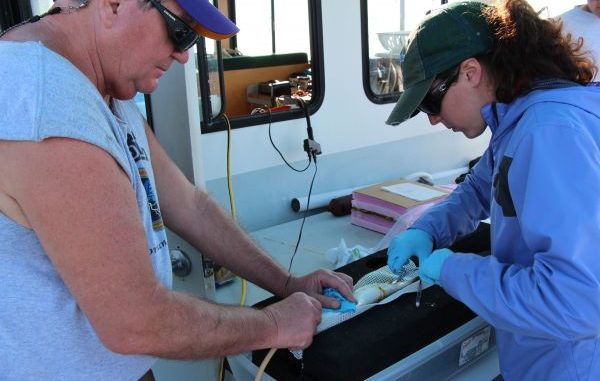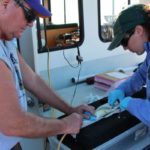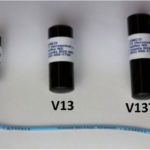
Fish seem to move east during spring and summer, occupy western and central parts of the lake in the fall and winter
Ashley Ferguson and Ashley Melancon aren’t avid anglers, but they probably know more about the movement of speckled trout in Lake Pontchartrain than most diehard fishermen do.
Ferguson, a biologist with the Louisiana Department of Wildlife and Fisheries and Melancon, a grad student working on her Ph.D. at LSU’s School of the Coast and Environment, have been working together on a telemetry project that tracks speckled trout movement by surgically implanting transmitters into fish and then tracking their movements with an array of 90 receivers that pretty much cover the lake.
Since November of 2012, the “two Ashleys,” as they’ve come to be known, have tagged more than 200 trout through the program, which is a cooperative endeavor between the U.S. Fish and Wildlife Service, LDWF and LSU’s Department of Oceanography and Coastal Sciences.
Although much of the data received is still preliminary, it’s definitely interesting material, especially if you love fishing spots like the Causeway, the Trestles, the twin spans and the Rigolets throughout the year.
“One of the biggest patterns we’ve noted is there is a strong seasonal movement pattern within the lake,” Melancon said. “We notice there is a random disbursement throughout the system in the fall and winter months, but as we approach spring and the salinities begin to drop, the fish gradually migrated over to the eastern end of the lake.
“That could be due to spawning, because they spawn in higher-salinity areas.”
Depending on the amount of spring rainfall, the salinity in the lake varies, Melancon said.
“Lake Pontchartrain is highly dictated by riverine discharge,” she said. “There’s a lot of discharge in the northwestern corner from the Tchefuncte, the Tangipahoa and Lake Maurepas has the Amite and Comite and Tickfaw rivers. All of the drainage, even if we get rainfall in Baton Rouge, all of that is draining into Lake Pontchartrain.
“And the Pearl River, even though its discharge is at the mouth of the Rigolets, when there’s an incoming tide a lot of that fresh water gets pushed into Lake Pontchartrain.”
Acoustic gates, or a series of overlapping receivers, are positioned near the Rigolets, Chef Pass and St. Catherine Pass to detect specks as they seasonally move out of, and then hopefully back into, the lake.
“Lake Pontchartrain is a good system to monitor because you can get them going in and out for the most part,” Feruson said. “They can escape through back marshes, but for the most part, they’ll go through either Lake Catherine, the Rigolets or Chef Pass.
“The receivers can hear, on average, a half mile, so if you place them in a position where they’re close enough to each other, it doesn’t positively mean you’ll hear every fish move in and out, but it really increases the chances.”
Melancon, who is compiling the raw data for her dissertation, said so far the lowest number of detections occurs in the middle of the summer.
“In October, November and December, we actually saw most of the fish in the western and central part of the lake, with a lesser degree in the east,” she said. “As we move into February and March, we saw them move more into the center of the lake. Beyond that, from April to the summer months, we saw the majority of the fish in the east.
“So there was this slow movement from the west to the east, utilizing the entire estuary in the process.”
Melancon stressed that the data was still preliminary and in some cases statistically insignificant, but said it appeared that females generally travel farther than males, and larger females may travel farther than smaller females.
Last year, of the 150 fish tagged at that point in the program, 26 left the system through one of the three passes, and five were detected making the return trip back inside.
It’s hard to know the fate of some of the fish since the battery-powered transmitters have a limited lifespan, but Ferguson asked anglers who catch a trout with a blue tag to return it to the water so it can continue to be part of the study.
“If they catch a speckled trout with a blue dart tag, it’s a telemetry fish. They’re the only ones I know of in Lake Pontchartrain at this point that will have a blue dart tag,” she said. “If they can record the number and length of the fish and put it back that would be great because we can continue to collect data on it.”
Anglers who call the number on the tag should note where the fish was caught, and it would be helpful to note how the fish has healed from having the transmitter implanted, she said. Even anglers who keep a tagged fish are encouraged to call in to report its size and where it was caught.
“I’ll send them a prize pack,” Ferguson said, noting she had a supply of hats and towels as thank yous to those who report their fish. “As much stuff as I can fit in a manilla envelope.”
More than 60 larger specks, many over 19 inches, were just tagged in the third week of April in what might be the final tagging event for the program.
Data from this last group has yet to be analyzed, but more than 500,000 detections of trout movement were recorded for the entirety of the program through March of this year.
“We feel like we know where they’re going,” Melancon said. “Now we’re trying to figure out why.”





